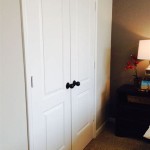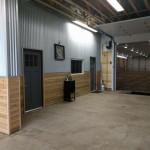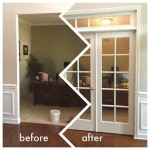How Long Does It Take To Paint The Interior Of A 3 Bedroom House
Painting the interior of a 3-bedroom house is a common home improvement project that can significantly enhance the aesthetic appeal and value of the property. However, accurately estimating the time required to complete this task can be challenging, as numerous factors influence the duration. This article will explore the various elements that contribute to the overall timeline, providing a comprehensive overview for both homeowners and painting professionals.
The time required to paint the interior of a 3-bedroom house is not a simple, fixed calculation. It varies significantly depending on multiple variables ranging from the square footage and condition of the walls to the painter's skill level and the type of paint used. A small, well-maintained 3-bedroom bungalow will naturally require considerably less time than a larger, multi-story house with extensive damage requiring repair.
Accurately calculating the painting time is essential for effective project management and budgeting. An underestimation can lead to rushed work, compromised quality, and cost overruns. Conversely, an overestimation can result in unnecessary delays and potentially higher labor costs. Therefore, understanding the key determinants is crucial for realistic planning.
Key Factors Influencing the Painting Timeline
Several crucial factors directly impact the time it takes to paint the interior of a 3-bedroom house. These encompass the size and layout of the house, the condition of the walls, the type of paint and application method, and the experience level of the painter.
The size of the house naturally plays a significant role. A larger house with more square footage will require more paint and more time to cover all the surfaces. The layout is also important; a house with many small rooms and intricate architectural details will generally take longer to paint than a house with fewer, larger rooms and simpler designs. Considerations such as high ceilings and hard-to-reach areas can add to the painting time.
The condition of the walls has a substantial impact on the duration of the project. Walls that are in good condition, with minimal imperfections, will require less preparation time. However, if the walls have cracks, holes, water damage, or peeling paint, they will need to be repaired and primed before painting can begin. This preparation work can significantly extend the overall timeline. Furthermore, if the existing paint is a dark color and the new paint is a light color, multiple coats may be necessary to achieve adequate coverage, increasing the time required. Textures on the walls can also influence the time required, as textured walls can be more difficult to paint evenly.
The type of paint selected and the chosen application method also contribute to the time required. Different types of paint have varying drying times, and some paints may require more coats than others to achieve the desired coverage and finish. For example, a high-quality paint with good coverage may require only one or two coats, whereas a lower-quality paint may require three or more. The choice between using a brush, roller, or sprayer will also influence the speed of the painting process. Spraying can be faster for large, open areas but requires more preparation and masking to protect surfaces from overspray. Brushing and rolling are generally more precise and suitable for smaller areas and detailed work.
The painter’s experience and skill level is a major determining factor. Experienced painters are generally more efficient and can complete the work faster and with a higher level of quality. They are also more likely to be able to anticipate potential problems and resolve them quickly. A professional painter will also have the necessary tools and equipment to complete the job efficiently and effectively, such as high-quality brushes, rollers, sprayers, ladders, and scaffolding. Novice painters may take significantly longer to complete the same job and may not achieve the same level of quality.
Detailed Breakdown of Painting Stages and Time Allocation
To accurately estimate the painting time, it's crucial to break down the project into its different stages and allocate the necessary time for each one. These stages typically include preparation, priming, painting, and cleanup. Each stage requires specific tasks and varying amounts of time depending on the factors mentioned earlier.
Preparation is a critical stage that often takes a significant portion of the overall time. This stage includes tasks such as moving furniture, covering floors and fixtures with drop cloths and plastic sheeting, taping off trim and windows, and repairing any imperfections in the walls. The amount of time required for preparation will depend on the size and complexity of the rooms, the amount of furniture that needs to be moved, and the condition of the walls. For example, if the walls have numerous cracks and holes, the preparation stage may take considerably longer to complete.
Priming is an important step that helps to create a smooth, uniform surface for the paint to adhere to. Primer also helps to block stains and seal porous surfaces. While not always required, priming is particularly important when painting over dark colors or when painting new drywall. The drying time for primer can vary depending on the type of primer used and the environmental conditions. Generally, primer needs to dry for at least a few hours before painting can begin.
The painting stage itself involves applying the paint to the walls using a brush, roller, or sprayer. The number of coats required will depend on the type of paint used, the color of the existing walls, and the desired finish. Each coat of paint needs to dry completely before the next coat is applied. Drying times can vary depending on the type of paint, the humidity level, and the temperature. In general, it's best to allow at least 4-6 hours of drying time between coats. Applying multiple coats too quickly can lead to issues such as blistering and peeling.
Cleanup is the final stage of the painting process and involves removing drop cloths and plastic sheeting, cleaning brushes and rollers, and putting furniture back in place. While it might seem minor, efficient cleanup is crucial for avoiding long-term issues. The time required for cleanup will depend on the size of the project and the amount of materials that need to be disposed of. Proper disposal of paint and cleaning supplies is also important.
Estimated Timeframes and Project Management Tips
Given the variability of factors, providing a single, definitive timeframe for painting a 3-bedroom house is impractical. However, providing ranges and guidance for estimation is helpful. A standard 3-bedroom house, assuming walls are in decent condition with minimal repairs, could take anywhere from 3 to 7 days to paint the interior. This assumes 2 people are working. If it is just one person, the project could take up to 2 weeks. This considers one coat of primer and two coats of paint.
For smaller 3-bedroom homes, particularly those with fewer rooms, simpler layouts, and minimal wall damage, the painting process could potentially be completed in 3 to 5 days. This assumes that the homeowner or painter works efficiently and has experience with painting.
Conversely, for larger 3-bedroom homes with more extensive wall damage, intricate architectural details, or the need for multiple coats of paint, the painting process could take 5 to 7 days or even longer. This is especially true if the project involves painting ceilings or trim work, which can add significant time to the overall timeline.
Effective project management is crucial for ensuring that the painting project stays on track and is completed within a reasonable timeframe. This includes creating a detailed plan outlining the different stages of the project, setting realistic goals for each stage, and monitoring progress regularly. It's also important to communicate effectively with all parties involved, including the homeowner, the painter, and any other contractors.
Preparation is also essential for maximizing efficiency and minimizing delays. This includes gathering all the necessary supplies and equipment before starting the project, ensuring that the work area is clean and organized, and taking steps to protect furniture and floors from paint splatters. Proper planning and preparation can save significant time and effort in the long run.
Flexibility is also important, as unexpected problems or delays may arise during the painting process. Being prepared to adjust the plan as needed can help to keep the project on track and minimize disruptions. This may involve re-prioritizing tasks, re-allocating resources, or making changes to the schedule. Maintaining open communication and a proactive approach can help to address any challenges that arise and ensure that the project is completed successfully.

Expert Painters Melbourne Painting Contractors Gordon Coating

House Painting Services Melbourne Timeline Explained

How Long Does It Take To Paint A 3 4 Bedroom House Original Style Painting And Decorating

How Long It Takes To Paint A House Interior An In Depth Guide Fresh Coat Painters

How Long It Takes To Paint A House Interior An In Depth Guide Fresh Coat Painters

Interior Painting Melbourne Cost Breakdown

How Long It Takes To Paint A House Interior An In Depth Guide Fresh Coat Painters

How Long It Takes To Paint A House Interior An In Depth Guide Fresh Coat Painters

How Long It Takes To Paint A House Interior An In Depth Guide Fresh Coat Painters

How Long Should It Take To Paint A 3 Bedroom House Melbourne Painter Solution
Related Posts








